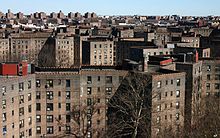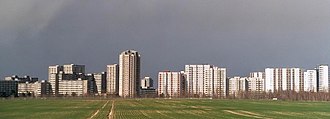Area renovation
The euphemism of area renovation denotes a historical urban planning concept that, based on a certain interpretation of the Athens Charter, aimed at the large-scale demolition of old buildings and subsequent redevelopment based on the model of the “ car-friendly city ”. However, examples of extensive area renovations can be found in the history of urban development long before this definition. The renovation of Paris by Georges-Eugène Haussmann can be cited as an outstanding example of the 19th century .
Area renovations all over the world
In the USA
The first large-scale cases of land redevelopment within the meaning of the Athens Charter took place in the United States from around 1940. As part of the New Deal , federal laws promoting redevelopment projects had been enacted there since the 1930s . The first law of its kind was the National Housing Act , passed in 1934 , the original aim of which was to give families in the poorer areas of the big cities easier access to mortgage credit. One of the undesirable side effects of the law, however, was greater urban sprawl on the outskirts.
However, other federal laws, in particular the Housing Act of 1949 , reinforced the direction that had been taken: Now the cities received two-thirds of the cost of purchasing land in redevelopment areas from the federal government. In addition to designating certain areas as redevelopment areas (so-called redlining ), the cities only needed to add a further third. As a result, the entire building stock in the area was torn down and new blocks of flats, including completely new streets, were built. In this way, for example, a large part of New York's Lower East Side was completely replaced in the 1950s . This practice changed the face of entire neighborhoods in many American cities and lasted until about the late 1960s. It was thanks in particular to the book The Death and Life of Big American Cities by the American urban planner and journalist Jane Jacobs that there has been a lasting change of opinion since then.
In England
The “cradle of the industrial revolution” naturally shows the oldest industrial cities in the world; many quarters had already been built around 1850. After the Second World War , at the latest , the historical buildings were no longer considered to be contemporary, especially since the traditional construction of many residential areas ( back-to-back houses ) had long been recognized as being unhealthy.
From 1957, for example, many old residential areas in Leeds were demolished; on this occasion the grid-shaped road network was also abolished. In their place, a relaxed cottage development with car-friendly streets and a courtyard was usually built .
Elsewhere, for example in Newcastle-upon-Tyne or Liverpool , modern multi-storey apartment blocks were built, as they were also in vogue on the continent from around 1960. This solution, however, fell into disrepute in England more than in the rest of Europe, as the pauperization of their tenants quickly degenerated into “modern slums ”. In the meantime, some of these residential complexes have been demolished themselves.
West Germany and West Berlin
After the great destruction of the cities in the Second World War , after many years of repairing war-damaged buildings after the economic restart, huge new building complexes were built on the outskirts of the cities .
In the western part of Berlin that - new suburbs arose Märkische district , the Gropiusstadt and Falkenhagener field . The idea of living better and “modern” here was well received.
As a result of the cost increases in the 1960s for the construction of the new building complexes in the area - the complete transport and supply networks had to be set up as well - the idea arose of making progress more cheaply by demolishing old districts and building new ones there. Infrastructure and supply systems (sewerage etc.) as a basis were already in place there.
One of the decisive factors was that “the entire technical and bureaucratic apparatus in the construction industry was geared towards the development of free space.” Likewise, the skilled workers and the capacities of the suppliers. Any change to a different approach would have meant high investments. In addition, demolition was a prerequisite for the implementation of the planned motorway plans around the city center.
The Urban Development Promotion Act (StBauFG ) drawn up on June 19, 1971 by the Federal Building Ministry under Minister Lauritz Lauritzen ( SPD ) , which was later included as a special town building law in Chapter Two ( Sections 136 to 191 ) of the Building Code , had increased demands on the planning , for the first time also named residents as affected and enabled the use of federal funds for funding, but there was still “considerable uncertainty regarding the possibilities of repair and modernization”.
An early, exemplary modernization of an old building by Hardt-Waltherr Hämer in the redevelopment area Berlin-Wedding Brunnenstrasse was denounced, "because the interest block in the building industry that dominated West Berlin at the time, in addition to the ruling social democracy that controlled building activity, above all the large non-profit housing associations were not interested in such a practice. They just wanted to show that modernization would be far too expensive and that it would therefore be better to tear down the old buildings and replace them with new ones. [... Also] the small business was the victim of a redevelopment policy that was declared social and subsidized with considerable public funds. "
However, the increasing costs and delays caused by the "tenant relocation" from the demolition houses became problematic. Special construction crews destroyed the interior fittings of 'free' houses, but the events also led to a general lack of understanding and resentment among the population, which also favored the repairers. Nevertheless, the resistance was 'academic' for a long time - the machinery for the renovation of the area continued to work until the early 1980s - half of Block 104 was still cleared until the corner house in Oranienstrasse on Heinrichplatz was occupied in October 1980.
In retrospect, it was clear in the IBA (and then in its successor organization “STERN”) that they would have achieved nothing 'without the squatters and the squatters nothing without the IBA'. And - according to Hämer: "The repair staff probably had the greatest impact at the time. For many Berliners, their breach of the law was morally justified. "
After a general rethinking by planners and architects, in politics and authorities, the massive commitment of those affected and under the impression of numerous squatting from the end of the seventies, the concept of cautious urban renewal could be implemented in 1983 as part of urban renewal under the leadership of Hardt-Waltherr Hämer , one of the directors of the International Building Exhibition (IBA). The careful urban renewal also became the basis for the redevelopment of the old building quarters in East Berlin from 1993. In the east, and later also in the west, the program for the protection of urban monuments followed , in which the historic town plan was expressly protected and promoted.
The reasons for the failure of the area renovation were different:
- The demolition of older buildings and, above all, entire city districts was fundamentally rejected.
- With the renovation of the area, the social fabric of a quarter was destroyed, as the residents - at least for the duration of the construction work - were relocated. The neighborhood structure was lost.
- The rents were then much higher than before.
- Examples of new building complexes (such as at Kottbusser Tor) show that there is “littering” and slum-like conditions. Anonymity instead of neighborhood.
- When planning quarters, facilities or basic needs of the population were neglected; the new residential areas did not find sufficient acceptance. There were children's playgrounds, but not an attractive offer for young people.
- Small-scale business and trade are being lost - shops are being replaced by supermarkets.
- Investors with short-term profit expectations often had difficulties maintaining their large building complexes adequately and developing them in an attractive way over the long term. Impersonality of the administration, long waiting for craftsmen.
Redevelopment of wasteland
A positive special form of area redevelopment is the redevelopment of urban wastelands, which is still carried out today. Urban wastelands arise z. B. by the migration of industrial companies from the city center. While many attempts are now being made to preserve and convert buildings , this is of course not always possible or sensible in every case and to the full extent, especially if there are also contaminated sites that also require renovation.
Examples of the redevelopment of urban wastelands can be found in Germany and abroad:
- Probably the largest urban wasteland in Germany, which also provides the most complex tasks, is located in Berlin . The area on which the Berlin Wall once stood stretches as a long ribbon through the entire city, including the government district and the city center. Squares such as Potsdamer Platz and Leipziger Platz were completely redesigned as there was virtually no development there. The government district was also almost completely redesigned.
- In the Japanese city of Yokohama , a large former port and shipyard area near the main train station is being transformed into the Minato Mirai 21 business district with leisure facilities. The work has not yet been completed. Almost the entire area is on raised land. The redesign tries to preserve some typical structures, e.g. B. two old docks, some lines of the port railway, which were expanded as a footpath and two large brick warehouses, in which today shops and event rooms are housed. Shopping centers with shops for upscale needs, restaurants, an art museum and hotels have emerged. In addition, the area was connected to Yamashita Park, a large green area directly on the water, within walking distance.
- In Erfurt there was a large industrial area directly behind the cathedral until 1990 . After reunification, it was shut down and a completely new district, characterized by contemporary architecture - the Brühl - was created. A new tram line, the Erfurt theater , a five-star hotel, a casino and numerous new residential buildings with around 2500 inhabitants have been built here, although the development is not yet complete. Office buildings were also built and former industrial buildings worth preserving were converted. We have succeeded in developing a new district without a dead character, which, thanks to its favorable location, is now one of the most expensive residential areas in the city.
literature
- "Urban renovation - urban renewal", in: Geography textbook NRW 9/10. Class, Stuttgart 1978;
Individual evidence
- ↑ Bernd Laurisch: No outline under this number , Werbund-Archiv 7, Anabas Verlag, Giessen 1981, p. 14.
- ↑ Urs Kohlbrenner: Upheaval in the Seventies - Fundamentals and models for conservative urban renewal in: Urban renewal Berlin, Ed .: Senate Department for Building and Housing, Berlin October 1990, p. 46.
- ^ Learning from IBA - the IBA 1987 in Berlin. Expert opinion on the IBA 1987 on behalf of the Senate Department for Urban Development, 2010, p. 16 f. (PDF), accessed on September 19, 2019.
- ↑ Hardt-Walter Hämer: Bewutsame Stadternerung , in: Stadternerung Berlin, Ed .: Senate Department for Building and Housing, Berlin 1990, p. 63.




